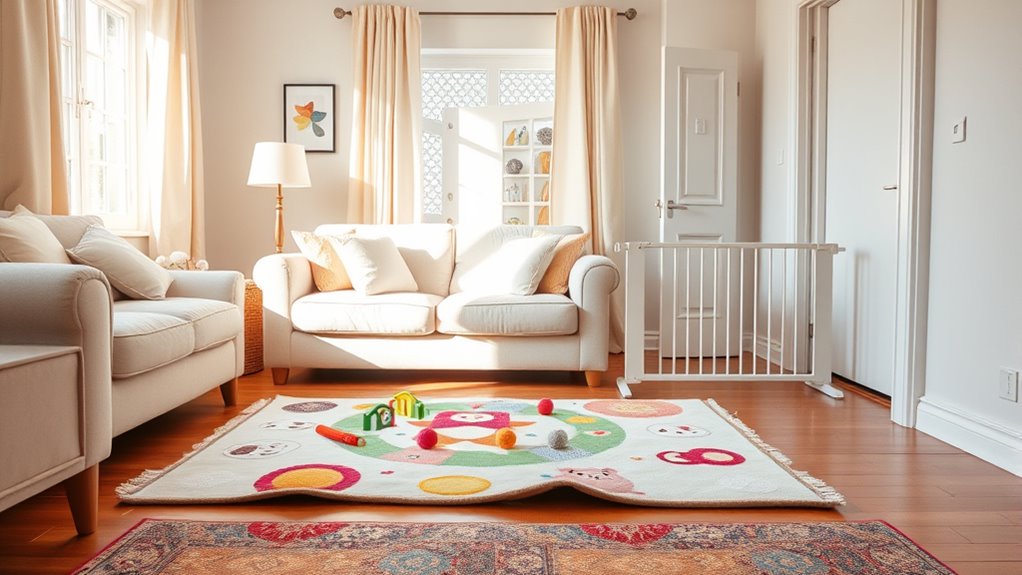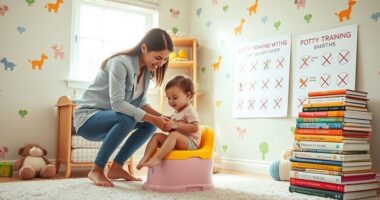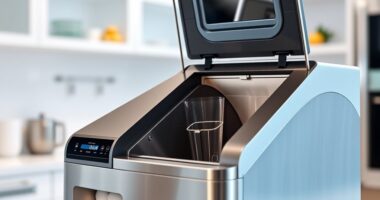Baby proofing your home is all about making it safe for your little ones. Start by securing heavy furniture to walls and using edge guards on sharp furniture. Keep electrical cords out of reach and use outlet covers. In the kitchen, install childproof locks and stove knob covers. Don’t forget about the bathroom—lock up medications and use non-slip mats. You’ll find that a few simple changes can create a safer environment. There’s more to explore on keeping your home secure.
Key Takeaways
- Secure heavy furniture to walls to prevent tip-overs and ensure stability in your living areas.
- Install childproof locks on cabinets and drawers to keep harmful items out of reach.
- Use non-slip mats in bathrooms and ensure rugs have non-slip pads to prevent slips and falls.
- Set up gates at stairways to restrict access and enhance safety for crawling and walking infants.
- Regularly inspect your home for hazards and update safety measures as your child grows.

When you welcome a baby into your home, ensuring their safety becomes a top priority. You’ll want to start with your living room, a space where your little one will likely spend a lot of time. Secure heavy furniture to the walls to prevent any tip-overs that could lead to injury.
Installing edge and corner guards on furniture with sharp edges is also a smart move. Keep electrical cords out of reach with cord management solutions and make sure your rugs are non-slip or have non-slip pads underneath to avoid any unexpected slips. Don’t forget to use outlet covers on all electrical outlets, as these are crucial for preventing curious hands from accessing them.
Moving into the kitchen, you need to take extra precautions since it’s filled with potential hazards. Install childproof locks on lower cabinets and drawers to keep dangerous items out of reach. Using stove knob covers and considering stove guards can help prevent accidents while cooking. You might also want to lock your refrigerator to keep your little one from snacking without supervision. Make sure your trash can has a secure lid or place it in a locked cabinet to prevent your baby from getting into anything harmful. Lastly, always use safety straps on high chairs during mealtime, as supervision in the kitchen is essential to prevent accidents.
In the bathroom, there are specific steps you should take to keep your baby safe. Toilet locks can prevent them from accessing the toilet, which can be a source of fascination. Store medications and cleaning supplies in locked cabinets to avoid any accidental ingestion. Non-slip mats in bathtubs and showers will help prevent slips, and keeping electrical appliances unplugged and out of reach is essential. Consider installing bathroom door locks to restrict access when you’re not around.
Don’t overlook stairway safety. Installing gates at both the top and bottom of stairs is crucial for preventing falls. Ensure that stair treads are secure and non-slip, and add sturdy handrails for support.
Adequate lighting on stairs is essential, so make sure you can easily see each step. Regularly cleaning stairs will further reduce slipping hazards.
Finally, maintain a general safety routine throughout your home. Conduct regular inspections for hazards, maintain a well-stocked first aid kit, and ensure your smoke alarms and carbon monoxide detectors are functioning properly.
Developing an emergency plan and continuously monitoring safety measures will help keep your home safe as your child grows.
Frequently Asked Questions
When Should I Start Baby Proofing My Home?
You should start baby proofing your home during pregnancy.
Planning early gives you time to assess each room for potential hazards and budget for necessary safety devices.
Focus on critical measures first, like securing furniture and installing safety gates.
As your baby grows, adapt your safety measures to match their new abilities.
Regularly inspect your home to ensure it remains a safe environment for your little one as they explore and develop.
How Much Does Baby Proofing Typically Cost?
Baby proofing typically costs between $180 and $614 for services, with an average around $389.
If you’re looking to baby proof your entire home, expect to spend anywhere from $500 to $2,500, averaging about $1,500.
Basic measures like gates and outlet covers can start at $250, while high-end options with smart devices or pool safety can reach up to $10,000.
Factors like home size and complexity also influence overall costs.
Can I Baby Proof a Rented Home?
Yes, you can definitely baby proof a rented home!
Focus on renter-friendly solutions that won’t damage the property. Use gates that don’t require screws, secure cabinets with magnetic locks, and cover electrical outlets with plug guards.
For safety, install corner protectors, and keep hazardous items out of reach.
Always check your lease for any restrictions and discuss your plans with your landlord to ensure you’re on the same page.
Your child’s safety is worth it!
What Are the Best Baby Proofing Brands?
When you’re choosing baby proofing brands, consider those that prioritize safety, convenience, and innovation.
Munchkin offers effective latches, Safety 1st provides comprehensive solutions, and Wall Nanny specializes in wall protectors.
For soft corner guards, Sure Basics is your go-to, while Heelalbaby presents clear safety corner protectors.
How Often Should I Reassess Baby Proofing Measures?
You should reassess your baby proofing measures regularly to ensure safety as your child grows.
Schedule monthly reviews to catch new hazards as they become mobile. Aim for quarterly updates to align with their developmental milestones.
After any renovations, conduct a thorough reassessment. An annual evaluation helps confirm that all safety devices are functioning correctly.
Staying proactive and vigilant about your child’s environment is key to maintaining a safe home.
Conclusion
In the dance of parenthood, baby proofing your home is like setting the stage for a safe performance. With each corner cushioned and every hazardous item tucked away, you’re crafting a sanctuary where curiosity can flourish without fear. Remember, you’re not just baby proofing; you’re building a fortress of love and protection. So gear up, embrace the journey, and let your little explorer roam free, knowing they’re safe in their wondrous world.









